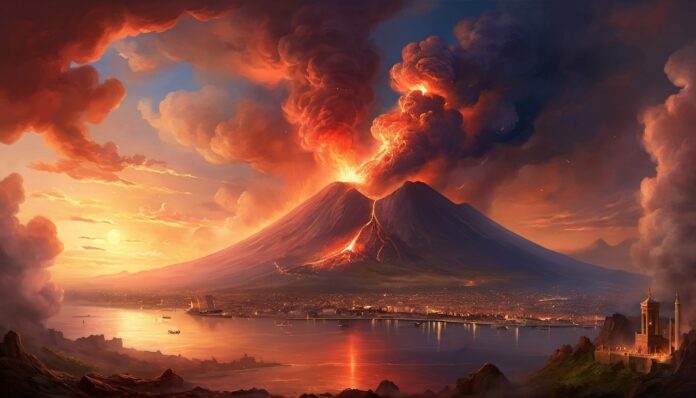Mount Vesuvius is one of the most famous volcanoes in the world. Located near the Bay of Naples in Italy, it erupted in AD 79, causing massive destruction. The eruption was so powerful that it buried the nearby cities of Pompeii and Herculaneum under layers of ash and pumice.
The City of Pompeii
Pompeii was a bustling Roman city before the eruption. It had a population of about 11,000 people and was a popular vacation spot for wealthy Romans. The city had beautiful villas, public baths, markets, and theaters. The people of Pompeii were going about their daily lives when disaster struck.
The Day of the Eruption
On August 24, AD 79, Mount Vesuvius erupted violently. The eruption lasted for about 24 hours, sending ash, rocks, and gas high into the sky. The ash began to fall on Pompeii, and within hours, the city was buried under several feet of it. The residents had little time to escape, and many were trapped.
Preservation Under Ash
The thick layer of ash that covered Pompeii preserved the city remarkably well. Buildings, streets, and everyday objects were frozen in time. Even the bodies of the victims were preserved, capturing their final moments in chilling detail. Archaeologists have discovered casts of these bodies, which provide a haunting glimpse into the past.
Rediscovery of Pompeii
Pompeii remained buried for nearly 1,700 years until it was rediscovered in the 18th century. Excavations began, revealing a well-preserved snapshot of ancient Roman life. The city’s layout, with its streets, homes, shops, and public buildings, offers valuable insights into the daily lives of its inhabitants.
Lessons from Vesuvius
The eruption of Mount Vesuvius serves as a stark reminder of the power of nature. It highlights the need for preparedness and understanding of volcanic activity. Today, scientists closely monitor Vesuvius and other active volcanoes to predict future eruptions and minimize their impact on nearby populations.
Modern Pompeii
Today, Pompeii is a UNESCO World Heritage Site and a popular tourist destination. Visitors can walk through the ancient streets, explore the ruins, and imagine what life was like nearly 2,000 years ago. The ongoing excavations continue to uncover new discoveries, adding to our understanding of this historic event.
Fascinating Facts About Vesuvius and Pompeii
- Active Volcano: Vesuvius is still an active volcano and could erupt again.
- Massive Eruption: The AD 79 eruption released about 1.5 million tons of volcanic material per second.
- Pyroclastic Flows: The eruption included deadly pyroclastic flows, fast-moving currents of hot gas and volcanic matter.
- Lost Cities: Pompeii and Herculaneum were completely buried and forgotten until their rediscovery.
- Survivors: Some people did manage to escape the eruption, though many did not.
- Pliny the Younger: A Roman writer, Pliny the Younger, documented the eruption, providing valuable historical accounts.
- Death Toll: It’s estimated that around 16,000 people died in Pompeii and Herculaneum.
- Pompeii’s Streets: The city’s streets were laid out in a grid pattern, similar to modern cities.
- Graffiti: Ancient graffiti found on Pompeii’s walls offers insights into the thoughts and humor of its people.
- Baths: Public baths were a central part of social life in Pompeii.
- Forum: The forum was the heart of Pompeii, where people gathered for business, politics, and social activities.
- Amphitheater: Pompeii had an amphitheater that could hold about 20,000 spectators.
- Preserved Food: Food items, like bread and fruit, have been found preserved in the ash.
- Paintings and Mosaics: Many beautiful paintings and mosaics have been uncovered, showing Roman art and culture.
- Pets: Remains of pets, like dogs and birds, have also been found in Pompeii.
- Roman Law: Legal documents and graffiti provide insights into the legal system of ancient Rome.
- Temples: Pompeii had several temples dedicated to Roman gods and goddesses.
- Bakeries: Many bakeries were found in Pompeii, showing the importance of bread in the diet.
- Wine: Wine was a major industry, with many vineyards surrounding Pompeii.
- Slave Quarters: Excavations have revealed the living conditions of slaves in Roman society.
- Plaster Casts: Archaeologists used plaster to create casts of the voids left by decomposed bodies, revealing their positions at the time of death.
- Jewelry: Items of jewelry found in the ruins show the wealth and fashion of Pompeii’s residents.
- Frescoes: The walls of many homes were decorated with frescoes, vibrant paintings that have been well-preserved.
- Daily Life: The ruins provide a detailed picture of daily life, including tools, utensils, and household items.
- Shopping: Markets and shops were an integral part of Pompeii’s economy.
- Stabian Baths: One of the oldest and best-preserved bath complexes in Pompeii.
- Lupanar: The city had a famous brothel with preserved erotic paintings.
- Mount Vesuvius: It is the only active volcano on the mainland of Europe.
- Resilience: Despite the tragedy, the story of Pompeii’s rediscovery has brought immense historical value.
- Tourism: Today, millions of tourists visit Pompeii each year to learn about and witness the preserved city.
